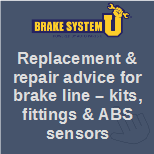Imagine you are driving uphill, and you need to pull aside for a little rest. But you don’t find a plain surface and since it’s a hill, the roads and roadsides are sloping. So, how do you get out of the car after pulling aside? Here is where an emergency braking system comes in handy.
 Emergency braking systems are secondary braking systems in a vehicle, even though they use parts of the primary braking system to perform their function, in terms of control, it is completely independent.
Emergency braking systems are secondary braking systems in a vehicle, even though they use parts of the primary braking system to perform their function, in terms of control, it is completely independent.
There are four types of emergency brakes. Stick lever, which is found under the instrument panel, center lever, which is found in between the front seats, pedal, which is found to the left of all the other pedals, push button which is found among other panel buttons.
How does an emergency braking system work?
 Unlike the primary braking system, the emergency braking system uses only cables and levers for braking. This independence makes sure that the vehicle can be brought to a complete stop even if the primary braking system fails. Most of the vehicles have a drum brake on the rear and so, the emergency system uses cables which directly lead to the brake shoes bypassing all the hydraulic components of the primary. The cables before reaching the brake shoes pass through a U-shaped equalizer, which divides the force equally to both the shoes.
Unlike the primary braking system, the emergency braking system uses only cables and levers for braking. This independence makes sure that the vehicle can be brought to a complete stop even if the primary braking system fails. Most of the vehicles have a drum brake on the rear and so, the emergency system uses cables which directly lead to the brake shoes bypassing all the hydraulic components of the primary. The cables before reaching the brake shoes pass through a U-shaped equalizer, which divides the force equally to both the shoes.
What if the rear wheel has a disc brake?
If the rear wheel has a disc brake instead of a drum brake, the braking is more complicated. In this case, there are two possibilities. The rear wheel can have an auxiliary drum apart from the disc, exclusively for the emergency brake. Otherwise, the rear rotor discs themselves are used for the purpose and braking is done by use of calipers. Much similar to the emergency drum brake, an additional corkscrew or lever is added to the existing caliper of the primary braking system. When the brake is activated, the screws push the pads in the caliper against the disc. Thus, it completely skips the regular hydraulic system which is otherwise used.
Taking care of the emergency brake
- It becomes important that you always keep the emergency brake under check, because the cable can become corroded and rusted. This could result in cable failure which can be extremely dangerous.
- In cold conditions, sometimes, the lever will not release even when the brake is disengaged. So, it is always better to park your vehicle safely in a garage and expose it less to extreme climatic conditions.
- In case the brake locks up in cold conditions, it’s highly undesirable to drive the vehicle. Another option is to not use the emergency brake in extremely cold conditions.